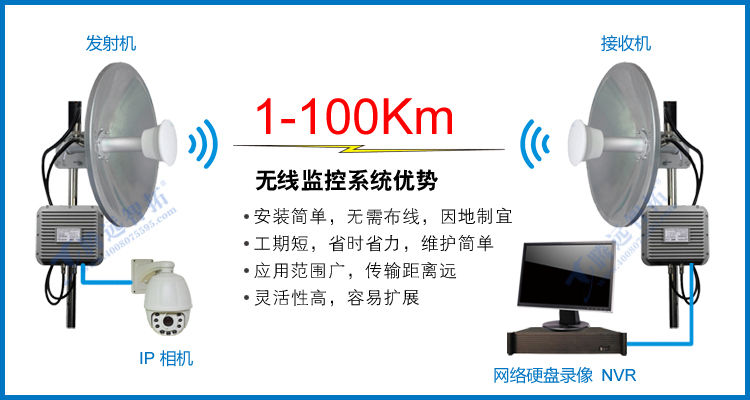What are the common problems encountered by wireless bridges during transmission?
In the long-distance monitoring system, the construction period using wired transmission is generally long, which brings great inconvenience to the construction project. Therefore, most merchants use wireless monitoring to achieve long-distance transmission, while wireless bridges are easy to install. The advantages of low cost and flexible networking are favored by engineering vendors. They are widely used in the wireless monitoring market. What problems are often encountered when using wireless bridges to achieve long-distance video transmission? Talk about it.

1. How far can the wireless bridge transmit?
The transmission distances of different environments are completely different, because the power of the equipment used, the obstacles are high, the walls are thick, the wall materials, the trees are dense and so on. Outdoor antennas, try to put the outdoor antennas at both ends to the height, so that the antennas and the antennas are wide and can be seen from each other. The transmission distance at this time is the transmission distance indicated on the data.
2. Is there a occlusion between the transmission and the reception to receive the signal? How far can it be transmitted?
As for whether the occlusion can receive the signal and how far the transmission distance depends on the scene environment, if there is an occlusion environment to transmit, then the attenuation of the wireless bridge is very large, then the transmission distance is definitely affected. Therefore, in order to ensure the stable transmission of the signal, then we must avoid the middle of the obstruction, to ensure that there is no occlusion between the transmission and reception.
3. Why do you say that wireless bridges that can be transmitted for several kilometers are not transmitted in a few hundred meters?
When we were testing outdoor antennas, we used the equipment to make the results. The receiving antennas were placed at a higher position to avoid blocking objects. For example, some people only consider the height of the antenna when testing, and do not adjust the angle of polarization, or the power level can not reach the same level of equipment. Therefore, the erected antennas can see each other as the minimum test condition.
4. Why is there an unstable situation after the wireless bridge is connected normally?
After the normal connection, it is equal to the mounting angle and height of the antenna, and there is no physical change in itself. Unstable conditions may occur at the joints of the feeder. For example, the contact resistance caused by long-term oxidation increases, and the operation of the device, for example, heat generation, DC power supply waveform, and the like. Of particular importance is the impact of the weather. It has been found through practice that rain and heavy snow have an impact on the signal. Therefore, we should consider the factors such as rain attenuation when selecting the wireless bridge for long-distance transmission, and increase the power and antenna gain of the transmitter to avoid the influence of external factors.
5. What is the difference between the transmission rate of the wireless bridge and the switch?
Compared with the transmission rate of wireless bridge data information, the switch is faster than the wireless bridge. At present, the transmission rate of the switch can reach 10 Gigabit, and the wireless bridge can only reach Gigabit. When the switch is working, it actually allows the channels between many groups of ports to work simultaneously. Therefore, the function of the switch reflects not only the function of a wireless bridge, but the collection of multiple bridge functions. That is, the wireless bridge generally has two ports, and the switch has a high density port.
The above is about the knowledge content of long-distance transmission of wireless bridges. Finally, Tengyuan Zhituo Xiaobian suggested that it is necessary to build a long-distance wireless bridge system with stable transmission. Professional and technical personnel should be instructed to install and do every detail in the installation and debugging process, so that the system can achieve good transmission results.
Freezer Room (also called Blast Freezer , shock freezer) is a kind of cold room with lower storage temperature from -40°C to -10°C, it is equipped with more thicker doors, Pu Panels and more powerful condensing units than cool room. Blast Freezer Room concerns of storing material reliably at consistently low temperature and fast cooling speed, so it can keep such stored products like sea food, meat or chicken in fresh quality.
As your cold room expert, we produce all Cold Storage cold room blast freezer for your fresh life. and provide all refrigeration Cold Room Solutions. Our slogan is Service warm, Provides cold.
What can we supply ?
Cold Room, prefabricated cold room, cold room panel; cold storage, industry cold storage, commercial cold storage;
Freezer room, blast freezer room, Walk In Freezer Room; Chiller Room , small chiller room, chiller room, cold storage freezer; cold storage refrigerator freezer;
Blast freezer, and Blast Freezer Container;
What we work for ?
Frozen seafood, frozen meat, frozen food, frozen chicken, frozen snacks; vegetable&fruits, milks, soft drinks, wine&bear, fruit juice, snacks, bread; medicine and chemical products etc.
Blast Freezer
Blast Freezer,Small Blast Chiller,Blast Freezer Room,Blast Freezer Container
Shandong Atlas Refrigeration Technology Co.,Ltd. , https://www.atlascoldroom.com
